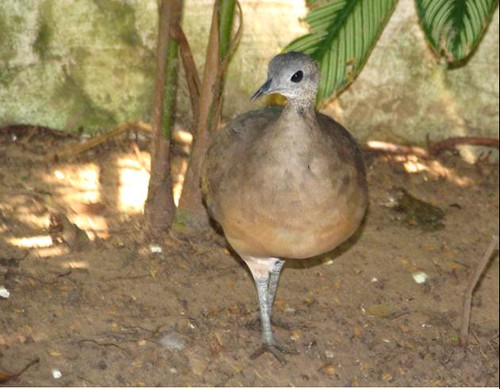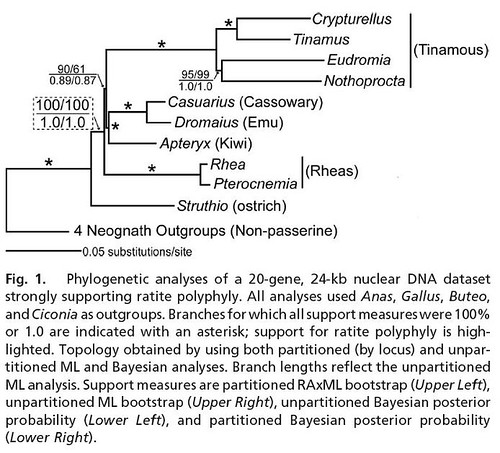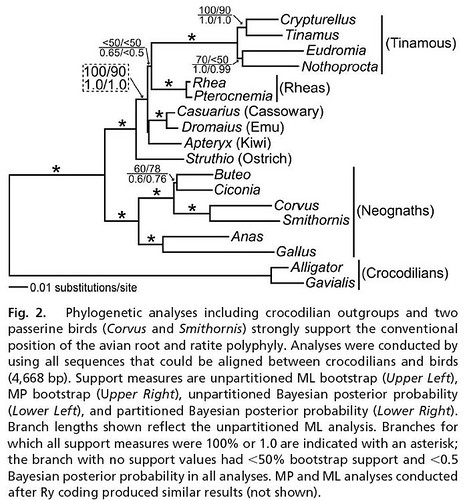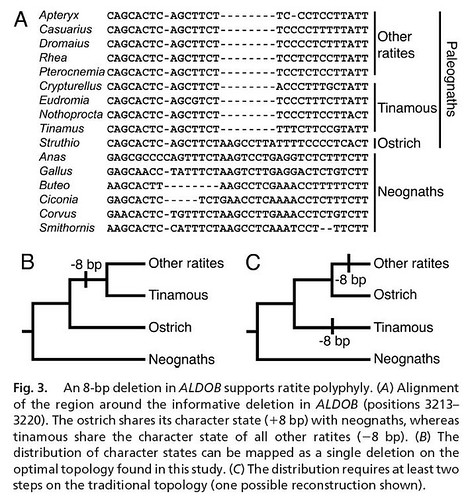tags: ratite, tinamous, evolution, biogeography, phylogenomics, convergence, flightlessness, Paleognath, homoplasy, vicariance
New research suggests the ostriches, emus, rheas and other flightless birds known as ratites have lost the ability to fly many times, rather than just once, as long thought. Further, the ratites appear to form a group with the tinamous, a group of birds that can fly, while the ostriches are set apart as the "sister group" -- the closest relatives.
Birds are divided into two groups based on jawbone morphology; neognaths and paleognaths. Neognaths include all birds except the tinamous and ratites, which are paleognaths. Ratites are an emigmatic group of flightless birds that are generally very large and lead a cursorial life. Ratites are recognized by the lack of a keel on their sternum, thus, they lack a stable skeletal anchor for their flight muscles, and this impairs their ability to fly. The closest relatives to the ratites were long thought to be the flighted tinamous, leading ornithologists to conclude that the ratites lost the ability to fly only once. Of course, if this is the case, this gives rise to a biogeographic mystery as to how the large flightless birds become distributed across so many landmasses, from Africa and South America to Australia.
But new research overturns this prevailing view of avian relationships. This research finds that the tinamous are not the ratites' closest relatives at all, but instead, they actually are ratites themselves. This finding also has important implications for the mystery of ratite biogeography, yet at the same time, it is surprising since it indicates that ratites lost the ability to fly more than once -- after they had dispersed.
To do this research, an international team of scientists led by John Harshman of Chicago's Field Museum of Natural History, analyzed the DNA from 18 taxa, including all living ratites, four tinamou species and eight "outgroups". (Outgroups are closely related species that are known to be phylogenetically outside the group of species being studied). Instead of relying on just one or a few regions of nuclear or mitochondrial DNA (mtDNA), this analysis relied upon using a phylogenomic approach, which analyzes data from many regions within the avian genome. In this case, the research team analyzed 20 loci that are widely dispersed throughout the genome, comprising sequences from both protein-coding (30 percent) and non-coding (70 percent) regions.
When analyzed, these sequence data provided strong support that the ratites and tinamous comprise one group (figure 1);
Additionally, if you look closely at the above phylogenetic tree, you will notice that it is the ostriches that are the sister group to all the other ratites, not the tinamous, as originally thought.
Further, these phylogenomic relationships remain unchanged after adding crocodilian DNA (crocodiles are the sister group to birds) and DNA from two additional neognath groups (figure 2);
More rigorous analyses of the regions surrounding deletions in the avian genome were conducted, and they too, provided strong support for the team's initial findings (figure 3);
Contrary to the prevailing hypothesis regarding avian evolution and biogeography, these data indicate that ratites lost the ability to fly at least three times; in ostriches, in rheas and in Australasian ratites. This is not as amazing as one might first think since several avian groups have evolved flightless members, particularly the rails (Rallidae), a group of birds that seems to specialize in losing the ability to fly as soon as they colonize an island as indicated by the hundreds of flightless rails have been identified.
Additionally, these findings are important for understanding the genetic mechanisms that underly flightlessness and how they are manifested during avian embryonic development.
In addition to providing new insight into avian evolution, these findings also have important implications for the continental drift hypothesis for how flightless birds became so widely distributed. Because ostriches live in Africa; rheas in South American; emus and cassowaries in Australia and New Guinea; kiwis and the extinct moas in New Zealand; and the extinct elephant birds in Madagascar; it was hypothesized that the ratites' biogeographic distribution pattern reflected the order in which these landmasses broke away from the early super-continent of Gondwana. However, this finding indicates that this is not the case, and that the pattern of appearance of ratites does not reflect the movement of these continental landmasses -- another example of the phenomenon that Huxley referred to as ''the great tragedy of science -- the slaying of a beautiful theory by an ugly fact.''
Source
J. Harshman, E. L. Braun, M. J. Braun, C. J. Huddleston, R. C. K. Bowie, J. L. Chojnowski, S. J. Hackett, K.-L. Han, R. T. Kimball, B. D. Marks, K. J. Miglia, W. S. Moore, S. Reddy, F. H. Sheldon, D. W. Steadman, S. J. Steppan, C. C. Witt, T. Yuri (2008). Phylogenomic evidence for multiple losses of flight in ratite birds Proceedings of the National Academy of Sciences, 105 (36), 13462-13467 DOI: 10.1073/pnas.0803242105.
- Log in to post comments





Article is missing the concluding sentence? (as that the new article shows that the order has nothing to do with continental drift?)
"Ostriches live in Africa" is a pretty myopic view. There were no ostriches in Africa before the Mio- or Pliocene (I forgot which). In Eurasia, they extend further back, probably to the Eocene of Europe (Palaeotis, possibly also Remiornis and Eleutherornis).
By contrast, rheas go back to the Paleocene of South America (Diogenornis).
Damn, that blows my assumption that Richard Dawkins is omniscient.
He has a fascinating piece in the "Ancestor's Tale" about ratites, saying that they became flightless first, and then "rafted" away from each other on the newly formed continents, ie the theory that you are now telling us has been debunked by this research.
But one wonders what it is about the ratites that predisposes them to flightlessness. There must be some factor(s), as with the rails.